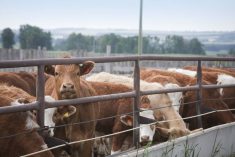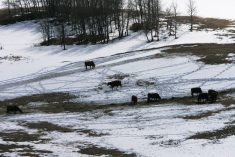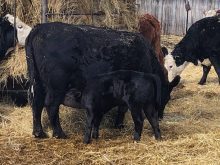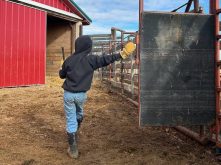The warm weather we had a couple of months ago has given me a false sense of security. I somehow think climate change lasts forever, yet one good arctic blast snaps me out of it. In the same way, producers should make sure that their pre-calving cows’ plane of nutrition is adequate during the last couple of months of gestation and to help animals combat inevitable frigid weather.
Such is the case as shown by the picture that I took last February. It shows a couple of cows from a well-managed 100 cow-calf operation. I know this producer very well and he has had many successful calving seasons in a row. His story is a testament of retaining the cow herd’s good body condition throughout winter until his last cow calves and then beyond toward the breeding season.
Read Also

Harvest wraps up and fall work begins
At the Eppich famly ranch in western Saskatchewan, the fall harvest was successful with few breakdowns, cows and calves have been sorted and a new tractor has arrived
His experience is a mirror image of many university research studies, which prove that overwintered mature cows and replacement heifers that calve at an optimum body condition score (BCS) of 2.5 to 3.0 (scale of one equals emaciation to five equals obese) have a greater chance of a trouble-free calving compared to skinny fresh cows. Clear advantages of an optimum BCS in beef cows at calving are: an easier birthing time, production of more, higher-quality colostrum, nursing a vigorous calf, and earlier return to estrus translating to faster rebreeding and pregnant with the next year’s calf.
Easy scoring technique
Although, there is no scientific method to judging BCS in beef cows, producers can a take a practical approach to scoring cows that I learned a long time ago. To start, I look straight along the tail and then feel the fat cover on the tail head, pinbones, hipbones, hind backbone and finally the last couple of ribs.
It’s easy. To me, a really thin cow (BCS < 2.0) looks skinny while an over-conditioned cow (BCS = 5), simply looks fat. In between, a cow with an optimum BCS of 2.5-3.0 should have a good overall appearance without the look of being “too gaunt or too fleshy.” Fat still covers her hips, but they are still visible and moderate pressure on them can still identify some bone structure.
I formulate diets to parallel the overall optimum body condition of the main cow herd during the last 90 days of pregnancy. I then increase the dietary energy, protein, mineral and vitamins by about 20-25 per cent depending on the BCS of the particular herd, which should take care of the dramatic unborn calf growth, placenta development and ammonic fluid accumulation, all of which allows the gestating cow to gain 1/2 to 3/4 kilo per day.
In addition, my formulation accounts for colostrum being manufactured in the cow’s udder and prepares the cow to resume estrus once she calves. I’ll also make further upward nutrient adjustments to the same diet as the weather gets colder based upon the a cold-weather rule of thumb, which dictates that for every 1 C drop in temperature below 0 C, the beef cow’s TDN energy maintenance requirements are increased by about two per cent. Despite natural metabolic triggers that simulate her feed intake by an additional 30 per cent, I seem to be justified to boost the dietary energy by 25-40 per cent at this time of year.
Easy rations to formulate
Luckily, I find the practical overwinter diets of pre-calving mature beef cows and first-calf replacement heifers (plus thin mature cows) are not particularly difficult to formulate if producers have a good forage inventory, which can be easily supplemented with high-energy grain and other feeds.
Adequate-quality grass hay or mixed grass-alfalfa mixtures make excellent pre-calving feeds often mixed with a little grain such as barley or grain byproducts such as distillers grain. Lower-quality forages such as poor-quality hay or cereal straw can be also adequately fed to pre-calving, as long as their feed intake by beef cows and nutrient limitations are recognized.
In these cases, the poorer forages should be blended with better-quality forages, or an extra complement of grain, or more protein might be needed. In addition to assuring an adequate supply of energy and protein for pre-calving cows, meeting their mineral and vitamin requirements is also very important. Commercial minerals with complimentary levels of calcium and phosphorus to those found in the forages and with good levels of trace minerals (copper, zinc, manganese, cobalt, iodine and selenium) and vitamins A, D, and E should be provided at the rate of 50-85 grams per head, daily. Salt and a good source of free choice water should also be included in the feeding program for expecting cows.
These feeding practices are followed by the same beef producer that owns those cows in the picture. He maintains a herd with a good body condition score of his late-trimester cows during the last few months of winter until the snows disappears by:
- Saving and feeding his better quality mixed grass hay during January to March
- Supplements a corn/barley mix with a mineral/vitamin premix and
- Has a well-bedded straw filled pole barn and makes good use of windbreaks in the dry lot. As a result, his cows successfully give birth to healthy and profitable calves, year after year.















